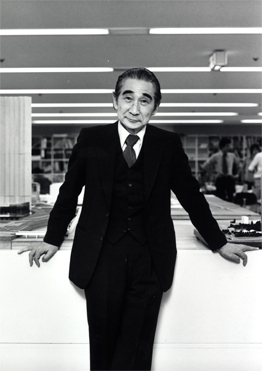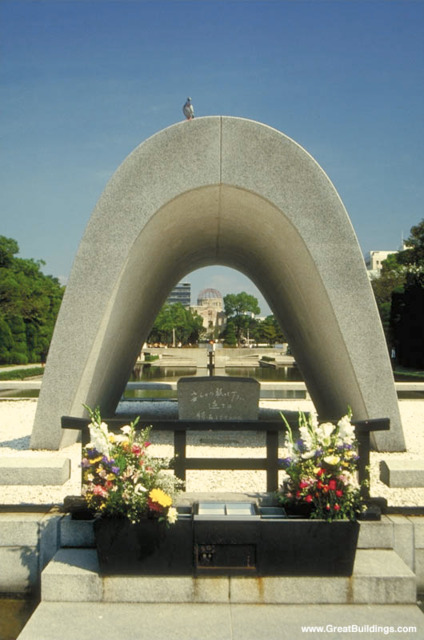Hiroshima Peace Memorial Park
Hiroshima Peace Memorial Park is located in the center of Hiroshima Japan and is dedicated to not only memorializing victims of the bomb, but it also advocates world peace. The Park is built on an open field that was created by the explosion. Today, the park has fifty-six memorials, monuments, museums, and lecture halls that attract over a million visitors annually. Furthermore, every year on August 6, the Peace Memorial Ceremony is held in the park to pay tribute to those who died as a result of the bomb.
Kenzo Tange (Designer/Architect)
 Kenzo Tange in all his glory
Kenzo Tange in all his glory Kenzo Tange (September 4, 1913 - March 22, 2005) was a world renown Japanese architect. His unique style combined elements of the Japanese aesthetic and expanded the scope with a more modern approach. Tange attended the Department of Engineering at the University of Tokyo where he worked toward his graduate degree in architecture. After a few years of work as an architect, he decided to venture back to University and continued his postgraduate studies. In 1949, Tange won the architecture competition for the design of the Hiroshima Peace Memorial Park four years after the atomic bombing of Hiroshima in 1945. A remarkable achievement considering he was still a graduate student and an assistant professor. Considering this was his first major large scale design project, he felt the need to embrace the industrial style of Le Corbusier.
"Inconsistency itself breeds vitality. The greatest overriding inconsistency is the one 'that arises from the confrontation of technology and human existence. We live in a world where great incompatibles coexist: the human scale and the superhuman scale, stability and mobility, permanence and change, identity and anonymity, comprehensibility and universality. These are the reflections of the gap between advancing technology and humanity as historical existence. I like to think there is something deep in our own world of reality that will create a dynamic balance between technology and human existence, the relationship between which has a decisive effect on contemporary cultural forms and social structure."
— Kenzo Tange. from Robin Boyd. Kenzo Tange. p15.
Tange's design concept for the peace memorial was inspired by his own philosophy on life. Everyday contradictions and inequalities, in his view, coexist solely to provide explanations to questions about cultural forms and social structures. Tange believes that design innovations in technology and human existence is evolving and are consistently shaping society.
The Memorial Cenotaph

Built in 1952, the Memorial Cenotaph was designed to resemble an ancient arch-shaped house. The arch was envisioned to symbolize a shelter for the victims of the atomic bomb from the harsh elements of the physical and spiritual world. The words "Please rest in peace, the mistake will not happen again" are inscribed into the monument as a farewell for the deceased. The inscription allows one to understand that war itself is a mistake and as a whole we must take responsibility for the injustices of the world and strive towards a common goal of peace. In the center of the monument lies a stone chest that holds the registry of the names of those who died in the bombing, regardless of nationality. Names are added to this registry when an application is filled out in honor of the dead. While the initial list included roughly seventy five thousand names, as the years progressed, this list grew to include those who have died from atomic radiation and related diseases. As of August 6, 2001, the registry was comprised of seventy seven volumes that listed a total of 221,893 names.
The A-Bomb Dome

The atomic bomb exploded almost directly above the dome of the Hiroshima Prefectual Commercial Exhibition Hall. The dome was not entirely destroyed due to the fact that the bomb exploded directly above. The wire framework of the dome has become a symbolic focal point in the Hiroshima Peace Park. The dome symbolizes the vow to pursue the abolition of nuclear weapons and ensure everlasting peace. The dome also withstood the destruction and reconstruction of Hiroshima City. Initially many of the citizens wanted to tear down the dome so that it was not a constant reminder of the bombing. However, in 1966 Hiroshima City determined to preserve the dome indefinitely. To date, the dome has undergone two preservation projects and has been declared a World Heritage Site in December of 1996.
Controversy
Designer Kenzo Tange was accused of placing underlying pro-militaristic elements into his design for the Hiroshima Peace Memorial Park. Accusations of promoting Imperial propaganda arose when more and more people looked into Tange's career. During his postgraduate years at the University of Tokyo, Tange submitted a proposal for the Greater East Asia Co-Prosperity Sphere park design competition. The park would commemorate the notion of the Greater East Asia Co-Prosperity Sphere, which was a government made concept to promote militaristic views. Interestingly enough, Tange's proposal for the Greater East Asia Co- Prosperity Sphere and his proposal for the Hiroshima Peace Memorial Park are fairly similar in terms of design and layout. Defenders of Tange, however, claim that he is simply a talented designer that can utilize established assets but also reshape the narrative to fit any given situation.
For a while, the primary museum lacked pre-atomic bomb history of Hiroshima. Instead, guests were treated to a panoramic display of Hiroshima with a time line that would span from August 6, 1945 8:15 am to the present. There was a red ball that was suspended in the air above the Hiroshima display to represent when and where the bomb exploded. Essentially the museum began at the time atomic bomb exploded. Many were outraged at the fact that the museum did not have a section for pre-atomic bomb history of Hiroshima. In 1994, however, the Hiroshima peace museum reopened with a new section devoted entirely to the pre-atomic bomb history of Hiroshima. The expansion helped bring in more history to those that want to understand the chain of events that led to the dropping of the atomic bomb.
The most notable of criticisms lies on the encryption of the cenotaph. The cenotaph reads, "Please rest in peace, the mistake will not happen again," which many right wing politicians and leaders condemned aforementioned encryption. Conservative opponents feel that the quote is too vague and can easily place blame on Japan for the victims of Hiroshima. This feeling , however, is not necessarily a general consensus. Most of Japan is not infuriated by the quote nor do they feel that one side has more responsibility then the other. The vagueness carries with it a simple message. Mistakes were made. The universal tie-in of peace once again is presented.
Sources Links
Christy, Alan (Podcast May 11, 2009)
http://www.greatbuildings.com/buildings/Hiroshima_Peace_Center.html http://www.ktaweb.com/en_index2.html
Log in to comment